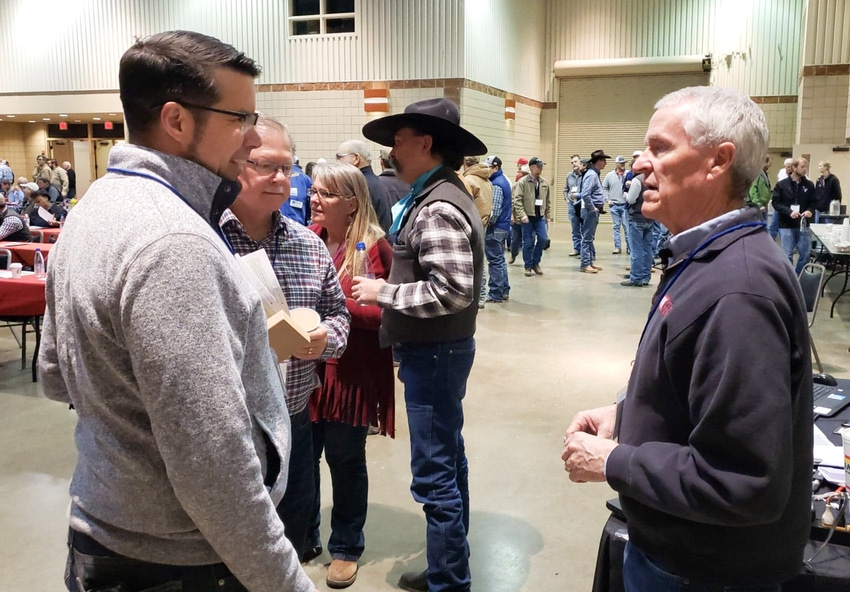
“You’re not growing plants, you’re growing microbes,” says a molecular biologist at the 2019 No-till Texas Soil Health Symposium at Amarillo, Texas, in February. Just as the stomach depends on microbiota for survival, Dr. David Johnson says, the soil does as well.
“Microbes make everything function and plants are part of that system,” says Johnson, a molecular biologist for both California State University’s regenerative agriculture initiative, and New Mexico State University’s sustainable agriculture. “The plants pull in energy from the sun, shuttle it to the microbes and the microbes, in turn, help to extract the nutrients those plants need. They put out phytohormones which improve plant growth. It’s a system we’re rebuilding.”

Dr. David Johnson
Johnson credits microbes for the following:
rebuilding soils and increasing soil fertility
producing more nutrient dense food and forage
using less water to grow crops by increasing both water-use efficiency and soil water storage capacity
reducing energy use by allowing nature to “fix” essential nutrients
reducing agrichemical pollution and atmospheric CO2 at the same time
improving productivity and profitability
A CHANGE IN PERSPECTIVE
But utilizing microbes requires a change in perspective, says Johnson. Rather than adding nutrients to the soil, he says it’s about adding microbes and allowing the microbes and the plant to determine what needs to be extracted from the soil material.
Microbes can be added to the soil by applying vermicompost or worm compost. “It gives you a diverse community of microbes you can inject into the soil and allows nature to choose from those organisms,” he says.
But just because the microbes are in the soil, doesn’t mean the plant will use all that’s available. “Much like a baseball team roster, you want a lot of good players to pick from,” he says. “It’s the same way with nature. When the selection of microbes goes on with the plants — this interaction between plants and microbes in the system — everything seems to function much better when the biology is there.”
Vermicompost transits all the compostable material through the intestines of a worm. As the compost matures, “we see four times the increase in microbial diversity,” explains Johnson.
And as the compost goes through the maturation process, some microbes are higher in population at the beginning and nonexistent at the end and vice versa, he says. “It's interesting to watch it mature and change in diversity throughout the composting process.”
LOW CARBON
In areas like the Texas South Plains, where some growers are being forced to transition from irrigated acres to dryland, Johnson says there is often a lack of carbon in the soil that needs to be rebuilt. “Right now, you have low carbon, so you can't infiltrate rain into your soil as well as a soil that's carbon rich. You can't hold it as well. The sands you have around here, the water goes straight through. But if you have that carbon component in there, it will hold the water and allow you to grow a plant.”
Add the microbes and Johnson says growers will begin to see increased efficiency in plant growth and in the use of captured sunlight. “You need an efficient microbiological system in order to grow the plant. And that's what the microbes bring back into it. Without the biology you lose this efficiency, you lose productivity and the water you get is not used effectively.”
Without everything in the system functioning, Johnson says it’s like an eight-cylinder engine running on seven. “You've lost so much power. But if you can start to bring this system back on line the water you get, you'll have more plant growth and more productivity.”
Soil carbon restoration holds the soil better, improves plant growth and increases water use efficiency. “There are a lot of benefits to this.”
BABY STEPS
For a grower interested in increasing their soil’s microbial activity, Johnson first recommends starting small.
“Prove to yourself it works. Try a small section. Be a little crazy and do something out of the ordinary,” he says.
Growers can also create their own microbial inoculum to treat their soils, a method Johnson and his wife Hui-Chun Su developed. For more information, go to “Composting Bioreactor,” https://youtu.be/DxUGk161Ly8 or download a PDF http://case.nmsu.edu/case/pasodelnorteagriculturalworkshops/documents/Johnson-Su_Bioreactor_BMP.pdf )
Johnson also recommends growers use resources such as YouTube or visit with others who are managing their soil health with a microbial mindset. “This is real,” Johnson says. “And if I hadn't backed into this and made a lot of mistakes, I never would have approached it this way.

Parmer County, Texas, grower and speaker at the 2019 Texas No-till Soil Health Symposium, Kelly Kettner, right, visits with Wendell Koehn, left, and Marlin Nickel, following his presentation.
“Observation is key to survival in this. If they're going to do it, it's got to observed, they’ve got to be open-minded, and they have to think more biology or microbiology.”
LEARNING CURVE
While Johnson admits there’s still a lot to learn about microbes, he says there’s also a lot of potential. “It seems promising. I have enough data to make it intriguing. It's not causation yet but we should start looking this direction. Look at what it's doing for the human microbiome. Why not try a little part of that in the field?“
To see a presentation on the benefits of microbes for improving productivity and profitability on farms, go to, Chico Presentation https://media.csuchico.edu/media/0_ysqa9svw ).
About the Author(s)
You May Also Like






